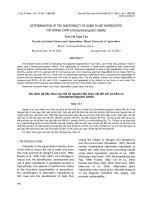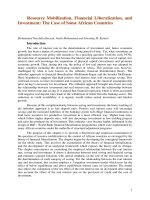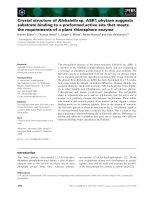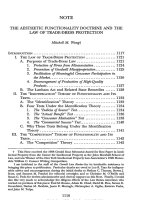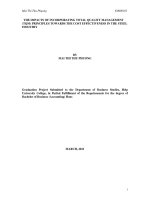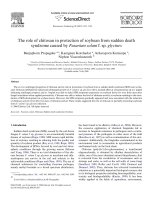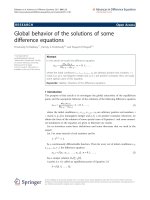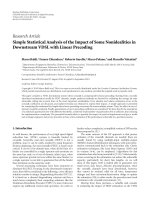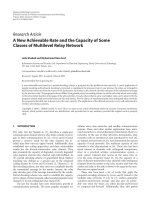The impacts of some plant protection chemical OCPs on two crustacean species Daphnia magna and Moina macrocopa
Bạn đang xem bản rút gọn của tài liệu. Xem và tải ngay bản đầy đủ của tài liệu tại đây (353.7 KB, 8 trang )
Vietnam Journal of Marine Science and Technology 2022, 22(1), 95–102
Vietnam Academy of Science and Technology
Vietnam Journal of Marine Science and Technology
journal homepage: vjs.ac.vn/index.php/jmst
The impacts of some plant protection chemical OCPs on two crustacean
species Daphnia magna and Moina macrocopa
Tran Thi Thu Huong1,*, Nguyen Xuan Tong2, Le Hung Anh2, Le Van Hau3
1
Faculty of Environment, Hanoi University of Mining and Geology, Hanoi, Vietnam
Institute of Environmental Science, Engineering and Management, Industrial University of Ho
Chi Minh city, Ho Chi Minh city, Vietnam
3
Department of Fisheries Biotechnology, Biotechnology Center of Ho Chi Minh city, Ho Chi Minh
city, Vietnam
*
E-mail:
2
Received: 17 May 2021; Accepted: 30 September 2021
ABSTRACT
DDT (Dichloro-diphenyl-trichloroethane) and chlordane are the organochlorine pesticides (OCPs)
dangerous to human health and easily accumulate in biological tissues, used to control insects in crops,
livestock and house protection. This study aimed to evaluate the toxicity of DDT, cis (alpha-chlordane),
and trans (gamma-chlordane) on the growth of two crustaceans species Daphnia magna (D. magna) and
Moina macrocopa (M. macrocopa) after 24 h and 48 h. Each test concentration selected 9 individuals of
each species and repeated 4 experimental times, the study results showed that the 50% lethal
concentration (LC50) of D. magna and M. macrocopa when exposed to DDT for 24 h were 20.8 μg.L-1
and 13.5 μg.L-1, respectively; after 48 h the value decreased to only 4.8 μg.L-1 and 1.7 μg.L-1. Similarly,
LC50 values of cis (alpha-chlordane) on 2 species after 24 h exposure were 12.4 μg.L-1 and 11.8 μg.L-1,
respectively; after 48 h were 4.6 μg.L-1 and 4.9 μg.L-1. The calculation results of LC50 when exposed to
trans (gamma-chlordane) of D. magna and M. macrocopa after 24 h are 17.6 μg.L-1 and 12.4 μg.L-1,
respectively; after 48 h, it decreased to 3.8 μg.L-1 and 3.7 μg.L-1 (p < 0.05). The results of the acute
toxicity assessment also indicated that M. macrocopa was more sensitive to toxicity than D. magna with
the same test conditions.
Keywords: D. magna, M. macrocopa, LC50, DDT, chlordane, toxicity.
Citation: Tran Thi Thu Huong, Nguyen Xuan Tong, Le Hung Anh, and Le Van Hau, 2022. The impacts of some plant
protection chemical OCPs on two crustacean species Daphnia magna and Moina macrocopa. Vietnam Journal of
Marine Science and Technology, 22(1), 95–102. />ISSN 1859-3097/© 2022 Vietnam Academy of Science and Technology (VAST)
95
Tran Thi Thu Huong et al./Vietnam Journal of Marine Science and Technology 2022, 22(1), 95–102
INTRODUCTION
Organochlorine pesticides (OCPs) are
persistent organic pollutants (POPs) that have
obtained a significant concern worldwide due
to their persistence, long-distance transport,
and bioaccumulation [1], negative impacts on
aquatic organisms, humans, the environment,
and ecosystems. Daphnia magna (D. magna)
and Moina macrocopa (M. macrocopa) are
two invertebrate crustaceans found in the most
freshwater ecosystems over the world, directly
affected by OCPs such as Dichloro-diphenyltrichloroethane (DDT), cis (alpha-chlordane)
and trans (gamma-chlordane). According to
the ECOTOX database, the most common
species used in the standardized toxicity
assessment include Ceriodaphnia dubia,
D. magna, D. pulex, and other daphnids such
as M. macrocopa and M. microra [2]. These
model organisms are susceptible to toxic
chemicals and occupy a central position in the
food chain [3]. In addition, D. magna and
M. macrocopa are indicator organisms with
high environmental sensitivity and easy to
identify and control toxic substances, so they
are usually used as standard organisms for
toxicity testing on a pilot scale. Therefore,
many previous studies have used D. magna
and M. macrocopa to evaluate water quality
and ecological toxicity [4–6]. However, there
is little information on the acute toxicity
assessment of OCPs on two crustaceans
D. magna and M. macrocopa, in Vietnam.
Several relevant published studies, such as
those evaluating the acute toxicity of
o,p’-DDT on fish Oryzias curvinotus embryos,
had recorded lethal concentrations of 50%
(LC50) of 0.0813 µg/L and 0.0406 µg/L at
24 h and 48 h, respectively, and these
concentrations have a substantial impact on
heart rate, organ malformations and eye
edema [7]. Another study showed that
endosulfan - a pesticide OCPs caused
morphological changes, affecting the growth
and survival of D. magna with LC50 values at
24 h and 48 h of 0.332 µg/L and 0.129 µg/L,
respectively [8]. This study was performed to
fill in the lack of data regarding the acute
effects of OCPs such as DDT, cis, and transchlordane on freshwater crustaceans.
96
This study aims to determine the effects of
OCPs, including DDT, cis, and transchlordane, on two crustaceans D. magna and
M. macrocopa. The experiments were
conducted in a medium containing the toxin to
estimate the concentration of LC50.
MATERIAL AND METHOD
Experimental organisms
D. magna was developed at the laboratory,
Institute of Science, Technology, and
Environmental
Management
Industrial
University of Ho Chi Minh at 21 ± 2oC, and the
light-dark cycle is 16 h:8 h with intensity
lighting varied from 500–800 lux.
M. macrocopa was obtained from the
Center for Biotechnology in Ho Chi Minh and
developed at 25 ± 2oC, and the light-dark cycle
of 16 h:8 h in medium-hard water (medium)
EPA [9].
The food for the experimental organism
was the unicellular algae Chlorella vulgaris,
once every 2–3 days and cleaned weekly. The
experimental organisms (24 h of age) were not
fed for 24 h before being collected for testing.
The medium used for the organism and the
experiments was tap water filtered through a
0.45 µm polymembrane filter. The dissolved
oxygen concentration was between 5 mg/L and
7 mg/L with pH 7–8. The culture period for one
generation was two weeks before testing.
Chemicals
The OCPs selected for experiments include
DDT, cis, and trans-chlordane derived from
Sigma-Aldrich with high purity (≥ 97%). The
chemicals were diluted into concentration
ranges according to the Mexican Norm NMXAA-087-SCFI guidelines [10].
Stock solutions were stored in dark glass
with rough stoppers at 4oC to minimize the
possibility of photodegradation.
Methodology
Experimental setup
Experiments were repeated four times in
a 6-wells SPL tray (Korea). Each
experimental well contains 9 mL of OCPs,
and the control sample well is absent of
chemicals. Nine individuals of D. magna and
M. macrocopa (24 h of age) were exposed to
Tran Thi Thu Huong et al./Vietnam Journal of Marine Science and Technology 2022, 22(1), 95–102
the chemical DDT at concentrations 0, 5, 10,
24, 30, 35 µg/L, and cis, trans-chlordane are
0, 4.5, 6.3, 9.2, 13.5, 19.8, 26 µg/L [11]. The
mortality rate at 24 h and 48 h exposure to
the chemical were recorded and calculated.
The experimental setup steps are shown in
Figure 1 below:
9 individuals D. magnal/M. macracopa (24 h of age)
9 mL DDT/cis/trans-chlordane (test sample),
filtered tap water (control sample)
Repeat 4 times
Observe the number of death at 24 h and 48 h
Calculation of LC50
Figure 1. Experimental setup steps
All experiments were done four times, and
the data were calculated as mean ± SE
10
(standard error) by the JMP 13 with a
significance level of p < 0.05. LC50 values at
24 h, 48 h, and p were calculated using the
statistical probity with SPSS 20 software [12].
RESULTS AND DISCUSSION
Effects of DDT
The results of the DDT toxicity assessment
on D. magna and M. macrocopa after 24 h and
48 h are shown in Figure 2 and Table 1.
Table 1 showed that the LC50 values on
D. magna and M. macrocopa when exposure
to DDT was 20.8 μg/L and 13.5 μg/L at 24 h,
respectively; After 48 h, the value decreased
to only 4.8 μg/L and 1.7 μg/L (p < 0.05). The
results showed that M. macrocopa is more
sensitive to DDT chemicals than D. magna
when exposed to the same concentration and
time of testing.
After 24 h exposure to DDT concentrations
of 0, 5, 10, 24, 30, 35 µg/L, the average
mortality rate changed of 0, 22, 33, 33, 39,
50% for D. magna and 0, 25, 36, 44, 58, 61%
for M. macrocopa, respectively (Figure 2a).
These results proved that DDT caused the
death of M. macrocopa individuals higher than
D. magna from concentrations > 10 µg/L.
10
a)
b)
D. magna
M. macrocopa
9
Số cá thể tử mortality
vong
Number of individuals
Số cá thể tử vong
Number of individuals
mortality
7
6
a
5
a
a
b
4
bc
3
c
c
2
0
b
8
8
1
a
9
bc
ab
bc
d
d
b
a
b
7
c
6
d
5
c
cd
4
c
3
e
2
1
d
0
-1
-1
0
5
10
15
20
25
30
Concentrations
(µg.L-1)
Nồng độ (µg L-1)
35
40
0
5
10
15
20
25
30
35
40
-1
Concentrations
Nồng độ (µg(µg.L
L-1) )
Figure 2. Variation in individual mortality of D. magna and M. macrocopa after 24 h (a)
and 48 h (b) exposure to 0, 5, 10, 24, 30, and 35 g/L DDT
97
Tran Thi Thu Huong et al./Vietnam Journal of Marine Science and Technology 2022, 22(1), 95–102
Although there was a change in mortality
between the two studied species, the value of
100% was recorded at the highest
experimental concentration (35 µg/L) after
48 h, including 0, 3, 42, 50, 78, 83, 100% for
D. magna and 0, 25, 47, 56, 64, 75, 100% for
M. macrocopa (p < 0.05) (Figure 2b).
Table 1. Toxicity of OCPs to D. magna and M. macrocopa
Chemicals
Values of LC50 (µg/L) (n = 4)
D. magna
M. macrocopa
20.8 (19.5–22.2)
13.5 (12.4–14.7)
4.8 (4.4–5.2)
1.7 (1.2–2.2)
12.4 (11.8–13.0)
11.8 (11.2–12.6)
4.6 (4.4–4.9)
4.9 (4.6–5.2)
17.6 (16.7–18.5)
12.4 (11.8–13.0)
3.8 (3.5–4.1)
3.7 (3.4–4.0)
Exposure time (h)
24 h
48 h
24 h
48 h
24 h
48 h
DDT
Cis-chlordane
Trans-chlordance
Note: Values in brackets represent lower and upper bounds with 95% confidence intervals.
Effect of cis-chlordane
The LC50 results on D. magna and
M. macrocopa after 24 h exposure with cischlordane were 12.4 μg/L and 11.8 μg/L,
respectively; after 48 h, the rates were 4.6 μg/L
and 4.9 μg/L (p < 0.05) (Table 1). When the
exposure time is prolonged, the toxicity of the
chemical
increases
and
reduces
the
survivability of D. magna and M. macrocopa.
Figure 3 shows the toxicity assessment
results of cis-chlordane on D. magna and
M. macrocopa at concentrations of 0, 4.5, 6.3,
10
9
9.2, 13.5, 19.8, and 26 μg/L. After 24 h
exposure with cis-chlordanc, the mortality rates
of D. magna and M. macrocopa were 0, 14, 28,
36, 44, 50, 61% and 0, 6, 14, 25, 33, 39, 47%,
respectively (Figure 3a). After 48 h, the
maximum mortality rate was 100%, the specific
values recorded of0, 36, 44, 53, 67, 81, 100%
and 0, 36, 50, 50, 61, 69, 97% (p < 0.05)
(Figure 3b). These results showed that the toxic
effect of cis-chlordane on D. magna was higher
than M. macrocopa under the same
experimental conditions.
10
a)
D. magna
M. macrocopa
7
a
a
6
ab
5
abc
4
bc
3
cd
2
de cd
0
a
a
8
Số cá thể tử vong
Number of individuals
mortality
Số cá thể tử vong
Number of individuals
mortality
8
1
b)
9
ab
bc
cd
de
e
e
-1
b
7
6
5
cd
4
e
3
d
de
bc
bc
b
15
20
cd
cd
2
1
0
f
e
-1
0
5
10
15
20
25
-1
Concentrations
)
Nồng độ (µg.L (µg.L
)
-1
30
0
5
10
25
30
-1
Concentrations
Nồng độ (µg(µg.L
L-1) )
Figure 3. Theindividual mortality of D. magna and M. macrocopa varied after 24 h (a) and 48 h
(b) exposure to 0, 4.5, 6.3, 9.2, 13.5, 19.8, and 26 μg/L pesticides cis-chlordane
98
Tran Thi Thu Huong et al./Vietnam Journal of Marine Science and Technology 2022, 22(1), 95–102
Effects of trans-chlordane
The LC50 values on D. magna and
M. macrocopa after 24 h exposure to transchlordane reached 17.6 µg/L and 12.4 µg/L,
respectively; however, after 48 h, the values
decreased to only 3.8 µg/L and 3.7 µg/L
(p < 0.05) (Table 1). The LC50 values in this
study indicated that M. macrocopa is more
sensitive to trans-chlordane than D. magna
when the exposure time is prolonged.
After 24 h exposure to 0, 4.5, 6.3, 9.2, 13.5,
19.8, and 26 µg/L trans-chlordane, the results
showed that the mortality rate of D. magna and
10
10
a)
D. magna
M. macrocopa
9
8
Số individuals
cá thể tử vong
Number of
mortality
Số individuals
cá thể tử vong
Number of
mortality
9
7
6
5
a
ab
4
3
bcd
cd
d
cd c
d
2
1
0
M. macrocopa increased 0, 11, 19, 22, 28, 36,
42% and 0, 17, 22, 28, 33, 39, 50%,
respectively(Figure 4a). After 48 h, the control
sample still did not detect dead individuals,
although, in the experimental sample, the
mortality rate gradually increased with the
results of 0, 50, 53, 75, 75, 83, 97% for
D. magna and 0, 47, 53, 64, 75, 83, 97% for
M. macrocopa (p < 0.05) (Figure 4b). The
study results on 2 chlordane isomers showed
that cis-chlordane’s toxicity to D. magna and
M. macrocopa is higher than trans-chlordane.
bc
bc
a
ab
e
e
8
b
7
b
bc
a
a
ab
b
cd
6
c
c de
e
5
4
3
2
1
0
-1
b)
d
f
-1
0
5
10
15
20
25
30
Concentrations-1(µg.L-1)
Nồng độ (µg L )
0
5
10
15
20
25
30
-1
Concentrations (µg.L
)
-1
Nồng độ (µg L )
Figure 4. The individual mortality of D. magna and M. macrocopa varied after 24 h (a) and 48 h
(b) exposure to 0, 4.5, 6.3, 9.2, 13.5, 19.8, and 26 µg/L pesticides trans-chlordane
DISCUSSION
OCPs enter water bodies through dry and
wet deposition from the air, accumulating in
rivers, lakes, and global oceans [13], causing
negative impacts on aquatic organisms. The
LC50 value recorded on D. magna after 48 h
exposure to DDT in this study was 4.8 µg/L,
which was higher than the value in the study by
Kuo et al., (2012) 1.4 µg/L [14] but lower than
the value recorded in the study by MejíaSaavedra et al., (2005) 5.2 µg/L [15], by Ivorra
et al., (2019) 260 µg/L [16]. After 48 h of
exposure to DDT, the LC50 value in this study
with M. macrocopa was 1.7 µg/L, much lower
than the result recorded by Liu et al., (2008)
324 µg/L [6]. Furthermore, when exposed to
DDT, the LC50 value on Hyalella azteca
crustacean was 0.17 µg/L, lower than the value
in this study. Due to the exposure time being
prolonged up to 96 h, so the toxic effect of the
chemical on the organism is also higher[17].
Several studies about acute toxicity have
reported that DDT affects the survivability of
fish and fish embryos under laboratory
conditions [18, 19]. Evaluation of acute toxicity
with o,p’-DDT on Oryzias curvinotus fish
embryos recorded LC50 values at 24 h and 48 h
of 0.0813 µg/L and 0.0406 µg/L, respectively
99
Tran Thi Thu Huong et al./Vietnam Journal of Marine Science and Technology 2022, 22(1), 95–102
[7]. The present study results showed that the
LC50 values on D. magna after 24 h and 48 h
exposure with cis-chlordane, and transchlordane, respectively, were 12.4 µg/L and
4.6 µg/L; 17.7 µg/L and 3.8 µg/L. These results
are lower than the values reported by Manar et
al., (2009), 22.6 µg/L and 13.4 µg/L,
respectively [20]. Some authors also noted that
chlordane affects not only the survival but also
the body size and fertility of D. magna [20, 21].
In addition, the LC50 values on fish with cischlordane and trans-chlordane were recorded at
7.4 µg/L [22] and 70 µg/L, respectively[23].
The results of the toxicological
assessment with OCPs showed that they were
capable of causing a 100% mortality rate in
both crustaceans, including D. magna and
M. macrocopa [24]. The experimental
conditions, such as chemicals [7], the
exposure time to toxic substances (long or
short) [25], were affected and toxic to aquatic
organisms. Thus, there is a close relationship
between the surviability of organisms with
the forms and concentrations of pesticides
added to the environment.
CONCLUSIONS
This study investigated the toxicity of DDT,
cis, and trans-chlordane on two crustaceans
D. magna and M. macrocopa. The results
showed that chlordane was more toxic on
D. magna (LC50 values at 24 h and 48 h were
12.4 µg/L and 4.6 µg/L for cis-chlordane;
17.6 µg/L and 3.8 µg/L for trans-chlordane,
respectively) compared with DDT (28.8 µg/L
and 4.8 µg/L, respectively). Evaluation results
on M. macrocopa also detected chlordane
toxicity (LC50 values at 24 h and 48 h were
11.8 µg/L and 4.9 µg/L for cis-chlordane;
12.4 µg/L and 3.7 µg/L, for trans-chlordane,
respectively) was higher than DDT (13.5 µg/L
and 1.7 µg/L, respectively) with the same
experimental
conditions.
The
results
demonstrated that survival of both species
decreased after exposure to DDT, cis, and
trans-chlordane
chemicals,
in
which
M. macrocopa was more sensitive to OCPs
than D. magna.
This study’s findings help improve
understanding of the adverse effects of OCPs
100
on freshwater aquatic animals. The results also
serve as a reference database for performing
toxicity tests against other crustaceans (these
groups have optimal growth limits in aquatic
ecology or marine environments).
Acknowledgments: The authors would like to
thank the Institute of Science, Technology and
Environmental Management - Industrial
University of Ho Chi Minh and the students’
enthusiastic support during the research. Many
thanks to the Biotechnology Center of Ho Chi
Minh for providing M. macrocopa in this study.
REFERENCES
[1] Tan, L., He, M., Men, B., and Lin, C.,
2009. Distribution and sources of
organochlorine pesticides in water and
sediments from Daliao River estuary of
Liaodongbay, Bohai Sea (China).
Estuarine, Coastal and Shelf Science,
84(1), 119–127. />j.ecss.2009.06.013
[2] USEPA, 2018. ECOTOX Knowledgebase.
/>accessed
June 18, 2018.
[3] Czech, B., Jośko, I., and Oleszczuk, P.,
2014. Ecotoxicological evaluation of
selected pharmaceuticals to Vibrio
fischeri and Daphnia magna before and
after
photooxidation
process.
Ecotoxicology and environmental safety,
104, 247–253. />j.ecoenv.2014.03.024
[4] Arndt, D. A., Moua, M., Chen, J., and
Klaper, R. D., 2013. Core structure and
surface functionalization of carbon
nanomaterials alter impacts to daphnid
mortality, reproduction, and growth: acute
assays do not predict chronic exposure
impacts. Environmental Science &
Technology,
47(16),
9444–9452.
/>[5] Niculescu, S. P., Lewis, M. A., and
Tigner, J., 2008. Probabilistic neural
networks modeling of the 48-h LC50 acute
toxicity endpoint to Daphnia magna. SAR
and QSAR in Environmental Research,
19(7–8),
735–750.
/>10.1080/10629360802550556
Tran Thi Thu Huong et al./Vietnam Journal of Marine Science and Technology 2022, 22(1), 95–102
[6] Liu, X. B., Xi, Y. L., Wang, J. X., and Hu,
K., 2008. Acute toxicity of DDT and its
effects on life table demography of Moina
macrocopa. Ying Yong Sheng tai xue
bao= The Journal of Applied Ecology,
19(6), 1343–1348.
[7] Huong, T. T. T., Tong, N. X., Binh, N. T.,
Anh, L. H., and Hong, D. T. B., 2019.
The impact of o, p-DDT pesticide toxicity
on the development of fish embryo
Oryzias curvinotus. Tap chi Sinh hoc,
41(2se1&2se2), 337–344.
[8] Tong, N. X., and Huong, T. T. T., 2019.
The impact of endosulfan pesticide
toxicity on the growthof Daphnia magna.
Vietnam Journal of Science and
Technology, 61(1), 21–25.
[9] Weber, C. I., 1993. Methods for
measuring the acute toxicity of effluents
and receiving waters to freshwater and
marine
organisms.
Environmental
Monitoring
Systems
Laboratory,
Cincinnati, Ohio (USA). United States.
Environmental Protection Agency.
[10] Secretaría de Economía, 2010. Norma
Mexicana
NMX-AA-087-SCFI-2010
Análisis
de
Agua-Evaluación
de
Toxicidad Aguda Con Daphnia Magna,
Straus (Crustácea-Cladócera)-MÉTODO
DE PRUEBA (Cancela a La NMX-AA087-SCFI-1995).
Secretaría
de
Economía: Cuauhtémoc, Mexico, pp. 39.
[11] Cooney, J. D., 1995. Freshwater tests. In
Fundamentals of aquatic toxicology:
effects, environmental fate, and risk
assessment, ed. GM Hand. pp. 71–102.
[12] Finney, D. J., 1971. Probit analysis,
Cambridge University Press. Cambridge,
UK. pp. 50–80.
[13] IARC Working Group on the Evaluation
of Carcinogenic Risk to Humans, 2018.
DDT, Lindane, and 2,4-D; International
Agency for Research on Cancer: Lyon,
France; ISBN 978-92-832-0179-3
[14] Kuo, J. N., Soon, A. Y., Garrett, C., Wan,
M. T., and Pasternak, J. P., 2012.
Agricultural pesticide residues of farm
runoff in the Okanagan Valley, British
Columbia,
Canada.
Journal
of
Environmental Science and Health, Part
B, 47(4), 250–261. />10.1080/03601234.2012.636588
[15] Mejía‐Saavedra, J., Sánchez‐Armass, S.,
Santos‐Medrano,
G.
E.,
Gonzáaaalez‐Amaro, R., Razo‐Soto, I.,
Rico‐Martínez, R., and Díaz‐Barriga, F.,
2005. Effect of coexposure to DDT and
manganese on freshwater invertebrates:
pore water from contaminated rivers and
laboratory
studies.
Environmental
Toxicology
and
Chemistry:
An
International Journal, 24(8), 2037–2044.
/>[16] Ivorra, L., Cardoso, P. G., Chan, S. K.,
Tagulao, K., and Cruzeiro, C., 2019.
Environmental characterization of 4, 4′dichlorobenzophenone in surface waters
from Macao and Hong Kong coastal areas
(Pearl River Delta) and its toxicity on two
biological models: Artemia salina and
Daphnia magna. Ecotoxicology and
environmental safety, 171, 1–11. doi:
10.1016/j.ecoenv.2018.12.054
[17] Lotufo, G. R., Landrum, P. F., Gedeon, M.
L., Tigue, E. A., and Herche, L. R., 2000.
Comparative toxicity and toxicokinetics
of DDT and its major metabolites in
freshwater amphipods. Environmental
Toxicology
and
Chemistry:
An
International Journal, 19(2), 368–379.
/>[18] Ton, C., Lin, Y., and Willett, C., 2006.
Zebrafish as a model for developmental
neurotoxicity testing. Birth Defects
Research Part A: Clinical and
Molecular Teratology, 76(7), 553–567.
doi: 10.1002/bdra.20281
[19] Wu, L., Ru, H., Ni, Z., Zhang, X., Xie, H.,
Yao, F., Zhang, H., Li, Y., and Zhong, L.,
2019. Comparative thyroid disruption by
o, p’-DDT and p, p’-DDE in zebrafish
embryos/larvae. Aquatic Toxicology, 216,
105280. />2019.105280
[20] Manar, R., Bessi, H., and Vasseur, P.,
2009.
Reproductive
effects
and
bioaccumulation of chlordane in Daphnia
magna. Environmental Toxicology and
Chemistry: An International Journal,
101
Tran Thi Thu Huong et al./Vietnam Journal of Marine Science and Technology 2022, 22(1), 95–102
28(10),
2150–2159.
/>10.1897/08-564.1
[21] Hamir, S. R. and Leo, M. L. N., 2012.
Pesticides. CRC Press. 662
p.
/>[22] Chlorinated Pesticide Standard, Safety
Data Sheet. According to Regulation (EC)
No. 453/2010. 2015.
[23] Lahens, L., Strady, E., Kieu-Le, T. C., Dris,
R., Boukerma, K., Rinnert, E., Gasperi, J.,
and Tassin, B., 2018. Macroplastic and
microplastic contamination assessment of
a tropical river (Saigon river, Vietnam)
transversed by a developing megacity.
Environmental Pollution, 236, 661–671.
doi: 10.1016/j.envpol.2018.02.005
102
[24] Arienzo, M., Albanese, S., Lima, A.,
Cannatelli, C., Aliberti, F., Cicotti, F., Qi,
S., and De Vivo, B., 2015. Assessment of
the concentrations of polycyclic aromatic
hydrocarbons
and
organochlorine
pesticides in soils from the Sarno River
basin, Italy, and ecotoxicological survey
by Daphnia magna. Environmental
monitoring and assessment, 187(2), 1–14.
doi: 10.1007/s10661-015-4272-5
[25] Narahashi, T., 2010. Neurophysiological
effects of insecticides. In Hayes’
Handbook of Pesticide Toxicology (pp.
799–817).
Academic
Press.
doi:
10.1016/B978-0-12-374367-1.00031-8
